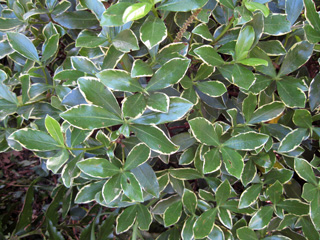Resource Library
Plant of the Week: Daphne, Winter
Plant of the Week
Winter Daphne
Latin: Daphna odora
 Though not common in Arkansas and considered challenging to grow, Winter Daphne is
one of the treasures of the garden if you can only get it to grow. (Image courtesy
Gerald Klingaman)
Though not common in Arkansas and considered challenging to grow, Winter Daphne is
one of the treasures of the garden if you can only get it to grow. (Image courtesy
Gerald Klingaman)
Download High Resolution
If gardening were easy, everyone would do it. In my quest to grow one of everything I’ve finally gotten around to attempting winter daphne (Daphne odora). All daphnes have a well-deserved reputation for being finicky to grow, but when successful they are one of the premier plants of the garden.
About 95 species of daphnes are described in the scientific literature with them classified in the old and still undivided Thymelaeaceae family. Most are small- to medium-sized deciduous shrubs or subshrubs, but Daphne odora is a mounded evergreen shrub to 4 feet tall and 5 feet wide.
It has bright shiny evergreen leaves to 3 inches long that are usually edged with a thin yellow or cream-colored margin. The variegated forms such as ‘Variegata’ or ‘Aureomarginata’ are most often cultivated because they are more cold tolerant than the non-variegated forms.
Flowers appear in late winter at the ends of branches in terminal clusters to 2 inches across. Individual flowers are tubular to a half-inch across and usually white on the inner surface while the outside of the floral tube is pink or lavender in color. ‘Alba’ has all white flowers. Though the flowers are beautiful in their own right, it is the fragrance that makes them a treasure in the garden. Daphne blooms saturate the air and can be sniffed out from a hundred feet away.
H.L. Li, in his 1959 Garden Flowers of China, says that this species has been in cultivation in China since the Sung Dynasty (960-1279). According to the 16th century Materia Medica, he says it originated in southeastern China in Jiujiant Province when a monk fell asleep on Mount Lu Shan and dreamed of a sweet fragrance. Upon awakening he tracked the scent to its source and discovered the plant. Since that time the plant seems to be extinct in the wild and now is known only in cultivation. It made its way to England in 1771 due to the efforts of Benjamin Torin, an employee of the British East India Company stationed in India.
Looking on the Internet to see where Winter Daphne is grown, shows it to be grown from Philadelphia to Alabama and on the West Coast from Washington to California. It is hardy in zones 7 through 9 but temperatures below 5 degrees Fahrenheit in the winter or high summertime temperatures can be problematic with its establishment. Ideally it should be nestled next to the home in a partially shaded, sheltered, south facing position where the soil is comprised of a rich, well-drained organic substrate.
The plants I have planted are in a creek side location with dappled light and moist, bottomland soil. I’m heartened by the fact that a close relative, Edgeworthia chrysantha, isn’t supposed to grow well in our west-of-the-Mississippi River-state but so far it has done reasonably well, only freezing back once. Though success is by no means guaranteed, the risk is worth it to grow such a beautiful garden plant.
By: Gerald Klingaman, retired
Retired Extension Horticulturist - Ornamentals
Extension News - June 4, 2014
The University of Arkansas System Division of Agriculture does not maintain lists of retail outlets where these plants can be purchased. Please check your local nursery or other retail outlets to ask about the availability of these plants for your growing area.